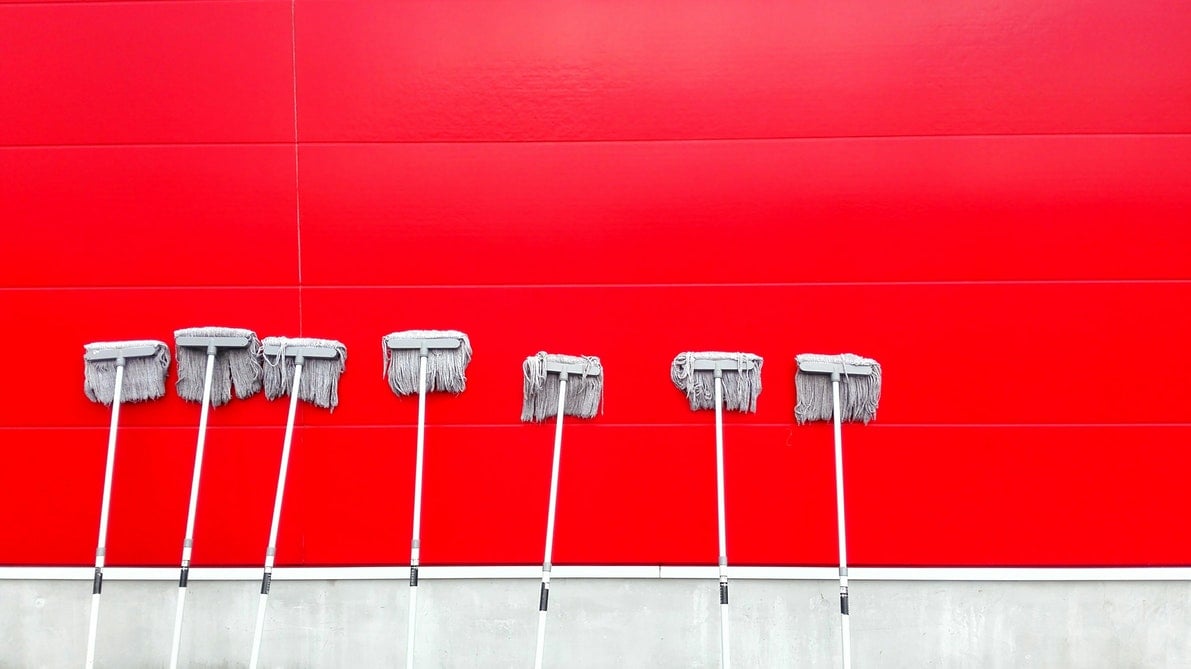1. Chances are you’re cleaning with dirty water.
Traditional floor cleaning puts the dirt from the floor into the bucket then back to the floor again. The use of a single cavity bucket limits proper cleaning because the solution is contaminated with the soiled rinse water. Dual bucket systems not only prevent cross-contamination, but they are also significantly lighter when full because only half of the bucket is filled. Buckets should also be fitted with quick release valves for wastewater dumping to prevent awkward lifting into sinks.

Microfiber flat mops paired with dual compartment buckets are an effective way to clean for health and sanitation. Together, they prevent surface and mop head re-soiling. The dense microfiber blend promotes deeper penetration for cleaner surfaces. Compared to a traditional mop head, microfiber mops can reduce bacteria by 96 percent.
3. “Cheaper” cotton string mops are costing you.While microfiber mops can cost up to three times the price of traditional cotton mops, they last for significantly more washings (some up to 500) and maintain effectiveness much longer. Microfiber durability and effectiveness maximizes the ROI within the first 150 washings.
4. Of all the tasks janitors perform, mopping is among the most dangerous.Mopping is the second-leading cause of cleaning-related injuries: These types of injuries result in significant financial loss to organizations in time, production efficiency, and worker’s compensation. If floor cleaning is a key service in business operations, it’s imperative to reduce or remove the possibility of repetitive motion injuries by choosing the appropriate, ergonomically designed tool for the task at hand.
5. Cleaners have a 10lb weight attached to the end of their mop.The most common sizes of wet string mops weigh between 16 and 24 ounces; these mops can triple in weight when wet. A 24-inch microfiber mop frame and handle with a damp mop pad attached weighs just over 2 pounds. Variations of the cotton string mop are still being used throughout the cleaning industry, despite advancements in materials. This is especially concerning because a wet string mop can weigh up to three times its dry weight, making it extremely hard on the wrists, hips, and back. Add a bucket of water that can tip the scales at 40 pounds and suddenly floor cleaning becomes a herculean task.

Most of a custodian’s time is devoted to floor care, providing lots of opportunities to develop repetitive stress injuries (RSI) – the second leading cause of cleaning-related injuries. The term RSI encompasses injuries that affect bones, muscles, nerves, and tendons due to overuse. This can be incredibly costly for organizations, and dangerous for custodians.
7. People don't all wear the same size shoe, but they are forced to use the same size mop.Mops with telescoping handles are ideal for cleaning processes because they enable the user to customize the tool to their appropriate height. If the handle isn’t suited for the worker, their hands cannot be correctly positioned to properly move the cleaning tool, which leads to awkward posture and ultimately causes high static shoulder muscle load.
8. Floor mopping takes up 35–40% of the working time in most cleaning jobs.Microfiber mops are versatile, easy to clean, and have longer life cycles than other mop materials in the marketplace. If the user is properly trained with the S-motion mopping technique, microfiber mops can quickly cover expansive areas with significantly less repetitious motion to the hips. Reduced weight also puts less strain on the worker’s back and prevents fatigue over time.
9. You could be cleaning twice as fast.An independent study conducted by ManageMen, Inc. in January of 2018 concluded that the Unger Excella™ cleaned 4,878 square feet per hour, compared to just 2,564 square feet per hour with a 24oz. string mop head, nearly doubling efficiency. The Unger Excella™ combines dual-swivel handles and a self-guiding S-curve pole, providing a mopping system that is “self-steering”. The system is the first available that includes both a height adjustable pole and the ability to dispense liquid from the bottle on board. This combination of features provides dramatically faster cleaning with less strain, stress, and effort than any other mop currently available.
Water quality, the type of mop, and how your cleaner is using that mop are important factors to consider to get the job done well and efficiently.
To learn more about how you could be cleaning smarter and more efficiently Click Below
About the Author
John Lombardo | VP of Marketing & Sales | Unger Enterprises, LLC




Enjoy this blog? Leave a comment or ask a question!